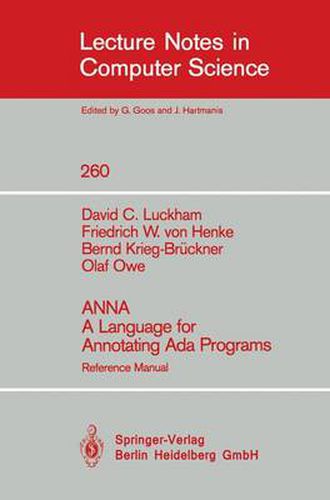Readings Newsletter
Become a Readings Member to make your shopping experience even easier.
Sign in or sign up for free!
You’re not far away from qualifying for FREE standard shipping within Australia
You’ve qualified for FREE standard shipping within Australia
The cart is loading…






This title is printed to order. This book may have been self-published. If so, we cannot guarantee the quality of the content. In the main most books will have gone through the editing process however some may not. We therefore suggest that you be aware of this before ordering this book. If in doubt check either the author or publisher’s details as we are unable to accept any returns unless they are faulty. Please contact us if you have any questions.
This reference manual of ANNA is another volume addressed to the ADA community. ANNA is a language extension of ADA to include facilities for formally specifying the intended behavior of ADA programs. It is designed to meet a perceived need to augment ADA with precise machine-processable annotations so that well established formal methods of specification and documentation can be applied to ADA programs. The current ANNA design includes annotations of all ADA constructs except tasking. Similar extensions for formal specification can be made to other Algol-like languages such as Pascal, PL/1, Concurrent Pascal, and Modula; essentially, these extensions would be subsets of ANNA. The design of ANNA was undertaken from the beginning with four principal considerations: 1. Constructing annotations should be easy for the ADA programmer and should depend as much as possible on notation and concepts of ADA. 2. ANNA should possess language features that are widely used in the specification and documentation of programs. 3. ANNA should provide a framework within which the various established theories of formally specifying programs may be applied to ADA. 4. Annotations should be equally well suited for different possible applications during the life cycle of a program. Such applications include not only testing, debugging and formal verification of a finished program, but also specification of program parts during the earlier stages of requirements analysis and program design.
$9.00 standard shipping within Australia
FREE standard shipping within Australia for orders over $100.00
Express & International shipping calculated at checkout
This title is printed to order. This book may have been self-published. If so, we cannot guarantee the quality of the content. In the main most books will have gone through the editing process however some may not. We therefore suggest that you be aware of this before ordering this book. If in doubt check either the author or publisher’s details as we are unable to accept any returns unless they are faulty. Please contact us if you have any questions.
This reference manual of ANNA is another volume addressed to the ADA community. ANNA is a language extension of ADA to include facilities for formally specifying the intended behavior of ADA programs. It is designed to meet a perceived need to augment ADA with precise machine-processable annotations so that well established formal methods of specification and documentation can be applied to ADA programs. The current ANNA design includes annotations of all ADA constructs except tasking. Similar extensions for formal specification can be made to other Algol-like languages such as Pascal, PL/1, Concurrent Pascal, and Modula; essentially, these extensions would be subsets of ANNA. The design of ANNA was undertaken from the beginning with four principal considerations: 1. Constructing annotations should be easy for the ADA programmer and should depend as much as possible on notation and concepts of ADA. 2. ANNA should possess language features that are widely used in the specification and documentation of programs. 3. ANNA should provide a framework within which the various established theories of formally specifying programs may be applied to ADA. 4. Annotations should be equally well suited for different possible applications during the life cycle of a program. Such applications include not only testing, debugging and formal verification of a finished program, but also specification of program parts during the earlier stages of requirements analysis and program design.